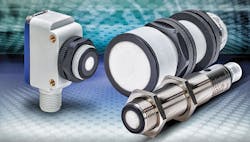The field of automation is based on a simple concept. Take something that can be done manually, and make a machine or process to do the function automatically. Keeping with that simple theme, automation depends on input signals to determine when an event happens and output signals to create a desired action. All the rest is just filler. Some of you may get a chuckle out of this crude analogy, as you can probably picture yourself using similar terminology to justify your existence to a boss or upper management.
Input devices come in all sorts of shapes and sizes but, at their base function, they come in two forms—digital and analog.
A digital sensor is, by its very description, either off (a 0) or on (a 1). A simple form of a digital sensor is a limit switch. A limit switch is a physical switch that uses a pivot point upon which a rod is mounted. One end of the rod will make contact with an object in motion and the other end activates a switch. When the rod is deflected far enough, it will make the opposite end change state on a pair of contacts. In the non-deflected state, the switch is open (or off), and in the deflected state, the switch is closed (or on).
An analog sensor translates displacement into a variable signal, reflecting the zero (off) position and points in between up to the fully deflected position. The most common form of analog signals are current (4-20 mA) or voltage (+/-10 V). Analog signals usually employ a concept called live zero. This approach makes it easy to identify when a wire is broken or no signal is present by making the physical zero equal to a value other than 0. Take, for example, the 4-20 mA current signal. Fully off is 4mA and fully on is 20 mA.
Sensors today still use these concepts, but the variety of sensors grows with each passing year. This article will focus on presence sensors and the technology employed to sense the presence of objects in a control system. Let’s review some of these.
A limit switch uses physical contact to deflect an operator. The position of the operator is translated into either a digital or analog signal. An example of the use of a limit (also called a finger) switch would be positioning the actuator in the path of an object travelling down a conveyor or a walking beam. The switch will remain in the zero (off) position until the object makes physical contact with the actuator as the object moves down the conveyor. The switch will return to the “off” position after the object moves out of the path of the actuator on the limit switch.
A cam switch is a variation of a limit switch where the operator rides on a rotary cam. The operator is opposed by a spring that keeps the switch in the off position unless the lobe on the cam deflects the operator enough to cause a change in state. Like a limit switch, the cam switch can be either digital or analog in nature. An example of the use of a cam switch would be in an electro-cam, where cams with different lobe shapes are mounted on a common rotary shaft, each with an associated cam switch. The shape of the lobes are machined to cause the cam switch to turn off and on at different times during the rotation of the shaft. The result is a means by which to provide timing signals to a control system.
The first two switches are examples of physical switches. The following are examples of non-contact presence sensors. In these examples, the sensors must be relatively close to the object but do not to come in physical contact.
[javascriptSnippet ]
A proximity switch is a transducer that takes advantage of the properties of the object to be sensed. They come in five forms: magnetic, capacitive, inductive, optical and ultrasonic.
A magnetic (reed) switch uses the properties of a magnet to sense the presence of an object. The original was invented by Bell Laboratories in 1938. A pair of flexible, ferro-magnetic contacts are contained in a casing. The close proximity of a magnet will cause the contacts to shift position (using the principles of like poles repelling) and either make or break contact. An example of the use of a reed switch can be found in a pneumatic actuator. A magnet is attached to the rod that travels inside the cylinder of the actuator. A reed switch (or more than one switch) is attached to the outside of the cylinder in such a position so as to come in alignment with the magnet that moves inside the cylinder in time with the extending and retracting of the cylinder rod.
A capacitive proximity sensor uses the change in capacitance between the sensor and the object to detect the presence of an object. In order for an object to be sensed by a capacitive sensor, the object must act as a dielectric. An application example of a capacitive sensor would be presence of a foil pouch inside a carton.
An inductive proximity sensor uses a fluctuating current to induce a magnetic field in the object to be sensed. The object to be sensed must be metallic in order to emit an electromagnetic force (EMF) when exposed to a fluctuating current from the sensor. An example of the application of an inductive sensor would be to sense the presence of the end of travel of the rod on a cylinder.
An optical proximity sensor uses the properties of light to sense an object. Optical sensors (also called photo eyes) use the travel of light in a variety of methods to sense an object, regardless of the method deployed. Examples of photo eye sensors include opposed (also called through-beam), retro-reflective and diffuse. In all three types, the object to be sensed impedes the travel of light from the sender (transmitter) to the receiver.
In a through-beam photo eye, the transmitter sends a beam of light to a receiver mounted directly opposite the transmitter. When an object blocks the path of the light, the receiver no longer receives the light and the resultant signal is turned “off.” These sensors are normally “on” and turn “off” when an object blocks the path of light from the transmitter, to the reflector and back to the receiver. This is the most accurate type of photo sensor but is the most difficult to install, as one must align the transmitter and receiver to a close degree of accuracy.
In a retro-reflective photo eye, light is transmitted by the sensor, bounces the light off a fixed, reflective surface and receives it back at the sensor. For this sensor, the sender and receiver are in the same sensor package. In higher ambient light situations, the use of a polarized reflector filters out light that doesn’t come at the reflector directly from the sensor, improving the intensity of the light at the receiver. Again, these sensors are normally “on” and turn “off” when an object blocks the path of light from the transmitter, to the reflector and back to the receiver. This sensor is slightly less accurate than a through-beam but is easier to install because the reflector is more forgiving, as far as placement relative to the sensor head.
ALSO READ: How to maintain presence sensors
[pullquote]For a diffuse photo eye, the transmitter and receiver are, again, in the same sensor housing. The difference here is the object itself is the mirror to reflect the light back at the sensor. These sensors are normally off (the receiver does not see the light sent out by the transmitter) and rely on the reflective properties of the object to deflect sufficient light back to the receiver. Due to the limited reflective qualities of the object, diffuse sensors are normally used to sense objects that are relatively close to the sensor. These sensors are the least accurate of the three types, as they must rely on the reflective properties of the object being sensed. The color and texture of the object can adversely affect the ability of the sensor to detect the reflected beam back at the receiver.
With all optical sensors, the type of light emitted by the sensor can greatly impact the efficacy of the sensor. For this reason, most photo eyes tend to use LEDs emitting in the infrared light spectrum. Newer photo sensors use class II laser technology to provide a more precise beam of light. This results in more accurate results over longer distances than infrared sensors. Fiber optics can be used to transmit light in a finer medium. Different light sources (colors) in a single sensor head also add to the functionality of the device. As the technology advances, more and more application control of the sensor is added to the sensor (or amplifier) to provide application-specific fine tuning.
The final type of non-contact proximity sensor is an ultrasonic sensor. The sensor head emits an ultrasonic wave and determines distance by measuring the amount of time it takes for the wave to be reflected back to the receiver. Ultrasonic is a great medium for distance sensing because it isn’t affected by dust. Sonic waves bounce off transparent objects like glass and plastic (light would pass through or get deflected). An example of an application for ultrasonic is the presence or level of grain in a silo or powder in a hopper.
While all proximity sensors can be both digital and analog in nature, only optical and ultrasonic sensors tend to be used in an analog application. The speed of sound, like light, is a constant, and this allows for the time from transmission to reception to be used as a means to measure distance. Due to these properties, most of the continuing development of optical and ultrasonic sensors tends to be based on getting more accuracy and user-configurable features out of the technology.
Control systems will always be called upon to keep up with the speed of life, and presence sensing will follow along with new technology to make it faster, more accurate and easier to use.
Rick Rice is a controls engineer at Crest Foods, a dry-foods manufacturing and packaging company in Ashton, Illinois. With more than 30 years’ experience in the field of automation, Rice has designed and programmed everything from automotive assembly, robots, palletizing and depalletizing equipment, conveyors and forming machines for the plastics industry but most of his career has focused on OEM in the packaging machinery industry with a focus on R&D for custom applications. Contact him at [email protected].
(Header Photo Source: AutomationDirect)
About the Author
Rick Rice
Contributing Editor
Rick Rice is a controls engineer at Trew Automation, a material handling manufacturer based in West Chester, Ohio. With over 38 years’ experience in the field of automation, Rice has designed and programmed everything from automotive assembly, robots, palletizing and depalletizing equipment, conveyors and forming machines for the plastics industry but most of his career has focused on OEM in the packaging machinery industry with a focus on R&D for custom applications.

Leaders relevant to this article:


